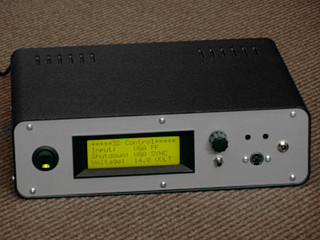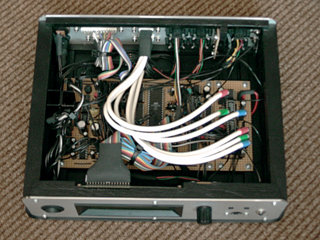| Author | Message | ||
Christoph Bungert (Admin) Rating: N/A |
I've got an Infocus LP70 DLP projector here and when playing stereo3d 60Hz NTSC stuff I see a red ghost. Obviously this is sync-related. The internal buffer is slightly behind the input signal. The time-gap is stable. I remember several users in the past who planned to construct a controller with manual time-gap compensation, mainly for use with 100Hz-CRT-TV-sets. Anyone has a design yet? By the way when using a 60Hz VGA 3D signal (nVidia driver) the time-gap isn't stable for me, it's ever cycling. It goes from full-ghosting to red-ghosting to perfect-ghost-free, then there's an 'image tearing' and it starts all over again. Hmmm, I'd need an nVidia refresh tool which allows fine-tuning of the refresh rate, at least in 1 Hz steps. Thank you Christoph | ||
Anonymous Rating: N/A |
Can't Powerstrip custom refresh rates adjust do that? just wondering you should be able to adjust vertical refresh in 1 hertz steps easily with that. | ||
Peter Wimmer Rating: |
I have built my own controller that could be modified to support time-gap compensation by improving the firmware. Bad news is, I don't have a DLP projector to test it. The "heart" of the circuit is a Atmel 8 MHz microcontroller, programmed in assembler. Almost all inputs are supported: VGA pageflip, interlaced, lineblanking, syncdoubling, composite video, s-video, parallel port, serial port, vesa mini din 3, 3.5 mm jack. Here are some images of the box (I call it "3D-Control"):  Front view  Back view  Circuits inside | ||
Anonymous Rating: N/A |
Peter, you obviously have WAAAY to much time on your hands! What did you build this for? | ||
Peter Wimmer Rating: N/A |
I built the controller for multiple purposes: 1) I did some experiments with softpageflipping on my Matrox G400 and needed to control the shutterglasses via parallel port. 2) I want to be able to make tests regarding shutterglasses timing, ir-protocols, ... 3) I did not have another controller. 4) I'm interested in electronics and like to to such stuff. :-) | ||
Christoph Bungert (Admin) Rating: N/A |
Anyone has a simple circuit layout for a TV-shutterglasses-controller with timing-compensation? Thank you Christoph | ||
Christoph Bungert (Admin) Rating: N/A |
Is there a way to use Powerstrip to modify nVidia stereo refresh rates? Christoph | ||
Christoph Bungert (Admin) Rating: N/A |
O.K. I just realized Powerstrip also does influence the timing of the stereo modes. It seems the native frequency of the projector is exactly 60 Hz. The closest I can get to 60 Hz with Powerstrip is 59,986. (Anyone knows parameters which get me closer to 60 Hz?) At 59,986 Hz the frame ratio between the VGA and the projector seems pretty stable, the time gap is constant, no 'tearing' effect. That's cool since I can watch DVD's and games without 'tearing'. The bad thing is: at this stable frequency I get no stereo. Both eyes see both images (full-ghosting if you will). Obviously the digitizing in the projector takes time, so the projector is behind the VGA-source 1/120 second or something, so the shutters open between 2 frames. Now I need a VGA-shutterglasses controller with time-gap compensation too :-) I ordered a DVI-cable, let's see what it'll achieve. Via DVI-digital-connection there may be no time-gap between VGA and projector. The typical frame-rate in DVI is again 60 Hz. The BIG problem may be: Where do I get the sync for the glasses from in a digital connection? Christoph |